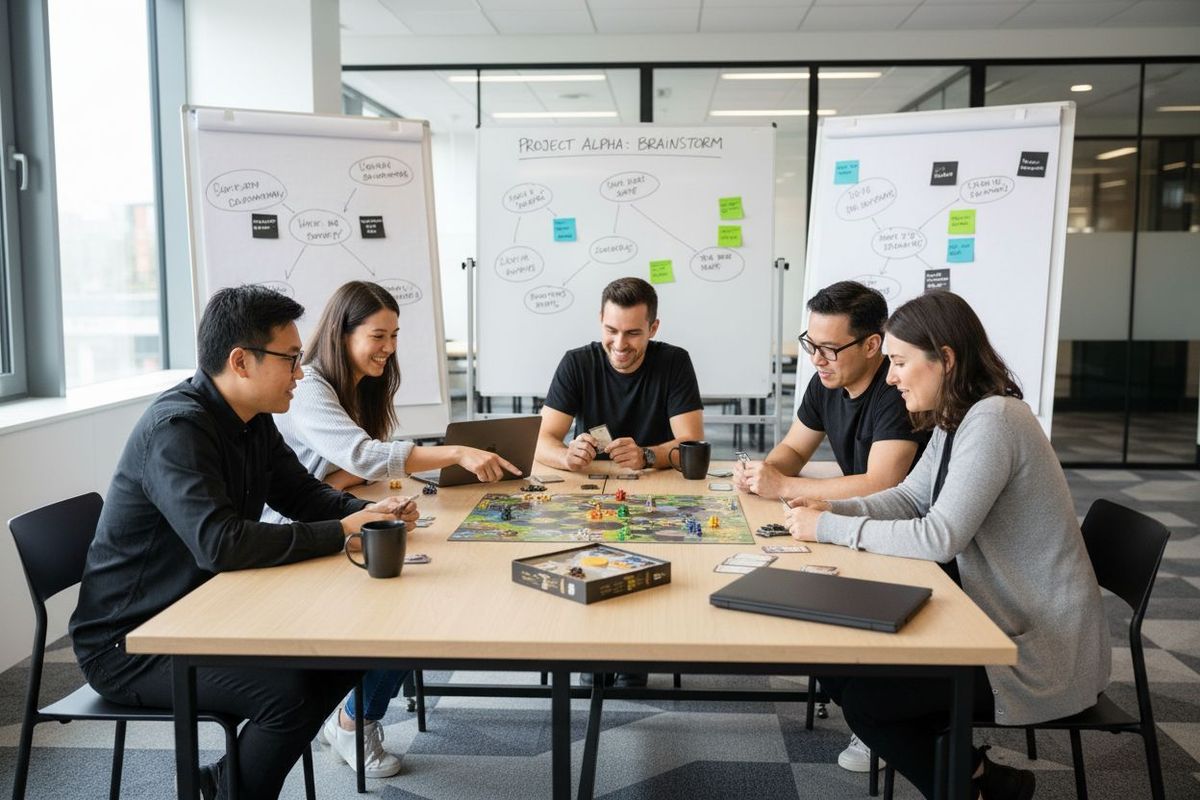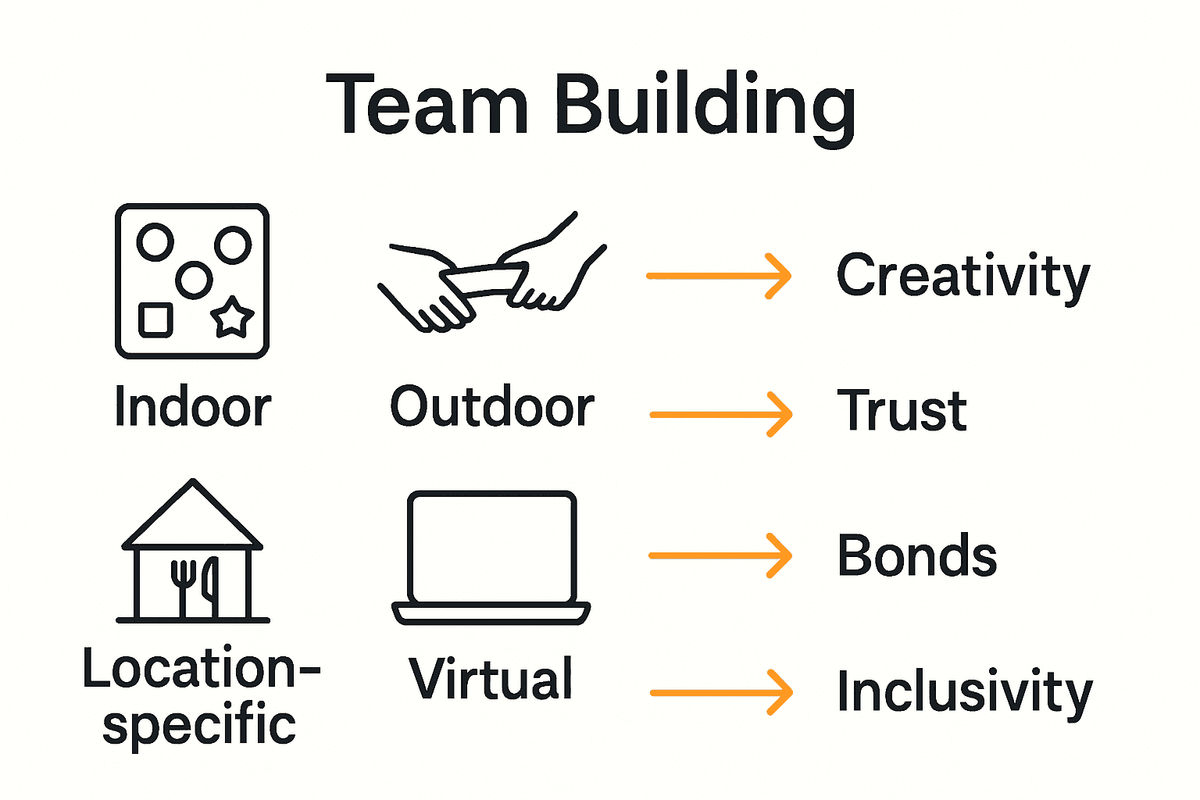What Is Team Building? Complete Guide for 2024
October 19, 2025

Did you know that teams with strong bonds can boost productivity by up to 25 percent, according to recent studies? Building trust and genuine collaboration can transform the way people work together and drive long-term success. Many businesses still misunderstand what team building truly means or expect quick fixes from a single workshop. Understanding its real purpose can help unlock the kind of sustainable teamwork that leads to progress and lasting results.
Key Takeaways
| Point | Details |
|---|---|
| Holistic Team Building | Effective team building requires addressing underlying organizational issues and fostering a culture of collaboration rather than temporary engagement. |
| Diverse Activities | Select team-building activities that align with specific goals and team dynamics to maximize engagement and efficacy. |
| Strategic Principles | Prioritize cooperation, consensus-building, and transparent communication to enhance interpersonal relationships and overall team performance. |
| Avoiding Pitfalls | Prevent superficial bonding by ensuring activities have clear objectives and are part of a sustained commitment to team development. |
Table of Contents
- Defining Team Building And Common Misconceptions
- Major Types Of Team Building Activities
- Core Principles And Key Benefits
- Modern Tools And Digital Team Building Platforms
- How To Avoid Common Team Building Pitfalls
Defining Team Building and Common Misconceptions
Team building is more than just corporate retreats or occasional icebreaker games. At its core, it's a strategic approach designed to enhance social relations, clarify team roles, and improve overall group performance. Our complete guide to team building concepts offers deeper insights into this critical organizational practice.
According to research from organizational behavior experts, effective team building centers on several key principles:
- Promoting cooperation over competition
- Encouraging collaborative problem-solving
- Facilitating consensus-building for sustainable decisions
- Improving communication flows across team structures
However, a significant misconception exists about team building. Many organizations mistakenly view it as a quick remedial solution for deeper systemic issues like poor communication or unclear leadership. In reality, team building is most effective when underlying organizational challenges are already being addressed systematically.
Successful team building requires a holistic approach that goes beyond surface-level activities. It demands intentional strategies that align team members' individual strengths, create shared understanding, and build trust. The goal isn't just temporary engagement, but sustainable improvements in collaborative performance and organizational culture.
Major Types of Team Building Activities
Team building activities are diverse and strategically designed to address different organizational needs. Check out our guide to big group team building games to discover exciting ways to engage your team. According to experts, these activities can be categorized into several distinct types that target specific team dynamics and skills.
Research reveals four primary categories of team building activities:
- Indoor Activities: Trivia contests, board games, and indoor problem-solving challenges
- Outdoor Activities: Physical challenges like relay races and group adventure experiences
- Location-Specific Activities: Group meals, volunteering projects, and collaborative local events
- Virtual Activities: Online escape rooms, remote puzzle challenges, and digital interactive experiences
Additional specialized team building formats include communication games like Back-to-Back Drawing, trust-building exercises such as blindfolded navigation courses, and problem-solving challenges like complex group puzzles. Each activity type serves a unique purpose: some focus on breaking initial barriers, while others aim to develop deep collaborative skills and mutual understanding.

Here's a comparison of the major types of team building activities and their primary benefits:
| Activity Type | Example Activities | Key Benefits |
|---|---|---|
| Indoor | Trivia contests Board games Problem-solving | Stimulates creativity Fosters teamwork |
| Outdoor | Relay races Group adventures | Builds trust Enhances communication |
| Location-Specific | Volunteering Group meals Local events | Strengthens bonds Engages community |
| Virtual | Online escape rooms Digital challenges | Connects remote teams Boosts inclusivity |
The key is selecting activities that align with your team's specific goals, communication styles, and current dynamics. Whether you're looking to improve communication, build trust, or simply have fun, there's a team building activity designed to meet your organizational needs.

Core Principles and Key Benefits
Team building is grounded in strategic principles that transform workplace interactions from mere transactional relationships to collaborative partnerships. Read our comprehensive guide on successful team building tips to understand how these core principles drive organizational success.
According to organizational behavior research, effective team building revolves around several fundamental principles:
- Prioritizing cooperation over individual competition
- Enabling collaborative problem-solving approaches
- Building consensus for sustainable decision-making
- Creating transparent communication channels
The benefits of implementing these principles are substantial and far-reaching.
Research indicates that strategic team building leads to:
- Increased employee engagement and job satisfaction
- Improved conflict resolution capabilities
- Stronger interpersonal workplace relationships
- Enhanced team creativity and innovation potential
- Higher overall productivity and performance metrics
Ultimately, team building is not about organizing occasional events, but creating a sustained culture of mutual understanding, respect, and collaborative excellence. By investing in intentional team development strategies, organizations can transform their workplace dynamics, turning individual contributors into a cohesive, high-performing collective that drives meaningful results.
Modern Tools and Digital Team Building Platforms
Digital team building platforms have revolutionized how organizations connect and engage employees, especially in remote and hybrid work environments. Learn more about technology's role in team building to stay ahead of emerging workplace trends.
Research highlights several innovative platforms designed to facilitate virtual team interactions:
- Interactive Discussion Boards: Enable real-time collaborative communication
- Virtual White-boarding: Allows teams to sketch and brainstorm together online
- Integrated Task Management: Supports shared planning and engagement
- Virtual Social Interaction Tools: Create digital spaces for team bonding
Some noteworthy digital team building tools include:
- Onethread: Comprehensive remote collaboration platform
- Zoom: Video conferencing with advanced interaction features
- HeyTaco!: Slack-integrated peer recognition system
- Donut: Randomly pairs colleagues for virtual coffee meetups
- Gather: Creates immersive virtual workspace environments
These platforms go beyond simple video calls, offering sophisticated features that mimic in-person interactions. By leveraging technology, organizations can create meaningful connections, foster team spirit, and maintain productivity across distributed workforces. The key is selecting tools that align with your team's specific communication needs and cultural dynamics.
How to Avoid Common Team Building Pitfalls
Team building is a nuanced process that requires strategic planning and genuine commitment. Check out our comprehensive manager's guide to effective team building to navigate potential challenges more effectively.
One of the most significant pitfalls organizations encounter is treating team building as a superficial band-aid for deeper systemic issues. According to organizational research, simply organizing activities without addressing underlying communication breakdowns or leadership challenges can lead to unproductive and potentially counterproductive outcomes.
Key pitfalls to avoid include:
- Using team building as a quick fix for complex organizational problems
- Forcing artificial team bonding without creating genuine connection
- Emphasizing competition instead of collaborative problem-solving
- Implementing activities without clear objectives or follow-up strategies
- Neglecting to create psychologically safe environments for open dialogue
To ensure successful team development, organizations must prioritize:
- Genuine cooperation over internal competition
- Creating safe spaces for honest communication
- Developing consensus-driven decision-making processes
- Aligning team-building activities with broader organizational goals
- Maintaining consistent, long-term commitment to team growth
Successful team building isn't about a single event or activity. It's a continuous process of nurturing trust, understanding, and collective capability. By avoiding these common pitfalls and focusing on meaningful, intentional approaches, teams can transform potential obstacles into opportunities for genuine connection and collaborative excellence.
Unlock Powerful Team Building With Custom Quiz Games
Is your team struggling to move beyond surface-level activities and achieve real collaboration? The article emphasized that one of the biggest pain points in team building is the gap between fun events and genuine, lasting teamwork. Many teams want more than temporary engagement—they seek interactive solutions that build trust, improve communication, and align with organizational goals.

Take your team building to a new level with Quizado’s customizable quiz games. You can create your own branded trivia experiences inspired by popular game shows. Our platform makes it easy to design engaging events that promote cooperation, creativity, and real problem-solving. Whether you want to host online sessions for remote teams or in-person competitions in the office, Quizado gives you the flexibility and personalization you need.
Do not let your team settle for outdated or disconnected activities. Start building a stronger and more connected team today. Visit Quizado’s homepage now and see how quick it is to spark genuine teamwork and boost collaboration.
Frequently Asked Questions
What is the purpose of team building?
Team building aims to enhance social relations among team members, clarify roles, and improve overall performance within a group. It fosters cooperation, effective communication, and problem-solving skills.
What are the different types of team building activities?
Team building activities can be categorized into indoor activities (like trivia contests), outdoor activities (such as relay races), location-specific activities (like group meals), and virtual activities (including online escape rooms). Each type targets specific team dynamics and goals.
How can organizations avoid common pitfalls in team building?
To avoid pitfalls, organizations should not treat team building as a quick fix. Instead, they should focus on creating genuine connections, emphasizing collaboration over competition, and ensuring activities align with broader organizational goals.
What are the key benefits of effective team building?
Effective team building leads to increased employee engagement, improved conflict resolution, stronger workplace relationships, enhanced creativity, and higher productivity, ultimately transforming individual contributors into a cohesive, high-performing team.



